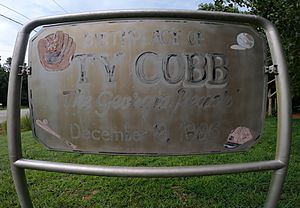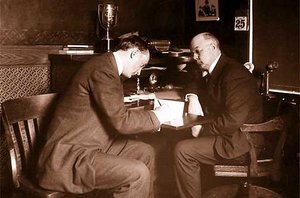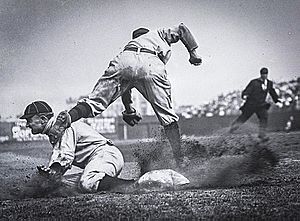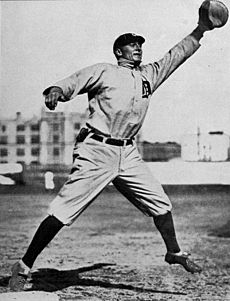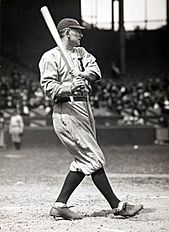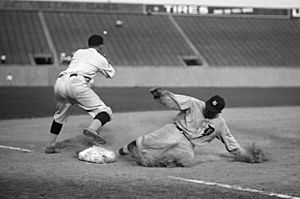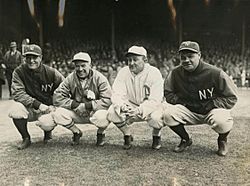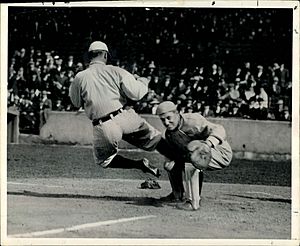Ty Cobb facts for kids
Quick facts for kids Ty Cobb |
|||
|---|---|---|---|

Cobb with the Detroit Tigers in 1913
|
|||
| Center fielder / Manager | |||
| Born: December 18, 1886 Narrows, Georgia, U.S. |
|||
| Died: July 17, 1961 (aged 74) Atlanta, Georgia, U.S. |
|||
|
|||
| debut | |||
| August 30, 1905, for the Detroit Tigers | |||
| Last appearance | |||
| September 11, 1928, for the Philadelphia Athletics | |||
| MLB statistics | |||
| Batting average | .366 | ||
| Hits | 4,189 | ||
| Home runs | 117 | ||
| Runs batted in | 1,944 | ||
| Stolen bases | 897 | ||
| Managerial record | 479–444 | ||
| Winning % | .519 | ||
| Teams | |||
As player
As manager
|
|||
| Career highlights and awards | |||
|
|||
| Induction | 1936 | ||
| Vote | 98.2% (first ballot) | ||
Tyrus Raymond Cobb (December 18, 1886 – July 17, 1961), known as "the Georgia Peach", was an American Major League Baseball (MLB) center fielder. He played for 22 seasons with the Detroit Tigers. For six of those years, he was also the team's player-manager. He finished his career with the Philadelphia Athletics.
In 1936, Cobb was among the first players chosen for the National Baseball Hall of Fame. He received more votes than any other player on that first ballot. Many people consider Cobb one of the greatest baseball players of all time. He set many MLB records during his career. For example, he still holds the record for the highest career batting average (.366). He also has the most career batting titles with 11 or 12, depending on the source.
Cobb's legacy includes a large college scholarship fund for Georgia students. He funded this with money from his early investments in companies like Coca-Cola and General Motors.
Contents
Early Life and Baseball Start
Ty Cobb was born in 1886 in Narrows, Georgia. This was a small farming community. He was the first of three children. His parents later moved to Royston, where he grew up.
From a young age, Cobb loved baseball. He dreamed of becoming a professional player. His father did not want him to play baseball. But Ty kept trying out for local teams. He played for the Royston Rompers and the semi-pro Royston Reds. He also played for the Augusta Tourists.
In August 1905, the Tourists sold Cobb to the American League's Detroit Tigers. He was sold for $750. This was a lot of money back then!
Amazing Baseball Career
Cobb made his big league debut on August 30, 1905. He played center field for the Detroit Tigers. In his very first time at bat, he hit a double. He was only 18 years old.
In 1906, Cobb became the Tigers' full-time center fielder. He hit .316 in 98 games. He never hit below that average again in his career. He helped the Tigers win three straight American League pennants from 1907 to 1909. However, the Tigers lost each World Series.
Record-Breaking Seasons
In 1907, Cobb showed his amazing base-stealing skills. He reached first base, then stole second, third, and home. He did this four times in his career. This is still an MLB record. He finished the 1907 season with a league-leading .350 batting average. He also had 212 hits, 49 stolen bases, and 119 runs batted in (RBI). At age 20, he was the youngest player to win a batting championship.
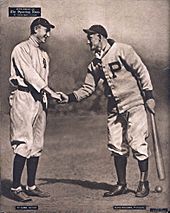
In September 1907, Cobb started working with The Coca-Cola Company. This partnership lasted his whole life. He owned many shares of Coca-Cola stock. He also owned bottling plants. He was a famous spokesperson for the drink.
In 1909, the Tigers won the AL pennant again. Cobb won the Major League Baseball Triple Crown. This means he led the league in batting average (.377), RBI (107), and home runs (9). All of his home runs that year were inside-the-park homers. This means the ball didn't go over the fence.
A famous photo from 1909 shows Cobb sliding into third base. It captures his fierce and determined playing style.
Cobb had an amazing year in 1911. He had a 40-game hitting streak. He led the AL in many categories. These included 248 hits, 147 runs, 127 RBI, and 83 stolen bases. He was voted the AL MVP that year.
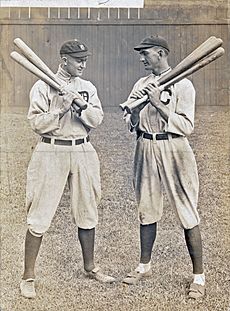
On May 12, 1911, Cobb showed his cleverness. Playing against the New York Highlanders, he scored from first base on a single. Later, he scored another run from second base on a wild pitch. In the seventh inning, he tied the game with a double. The Highlanders' catcher argued with the umpire. While everyone was distracted, Cobb quietly walked to third base. Then he suddenly ran home, scoring the winning run! This showed how smart he was on the field.
Cobb believed in playing aggressively. He would try bold plays to make the other team nervous. He always looked for ways to surprise his opponents.
On May 15, 1912, Cobb had a conflict with a fan. The league suspended him. His teammates, even though they didn't always get along with Cobb, went on strike. They protested the suspension and the lack of protection from abusive fans. For one game, Detroit had to use a replacement team. They lost 24–2. The strike ended when Cobb asked his teammates to return. This event helped lead to the creation of a players' union.
In 1913, Cobb signed a contract for $12,000 for the season. This was a very high salary for a baseball player at the time.
In 1915, Cobb set a new record for stolen bases in a single season with 96. This record stood for many years. He also won his ninth straight batting title, hitting .369.
During spring training in 1917, Cobb was involved in a fight with another player, Buck Herzog. The Dallas Police Department had to help stop the fight. Cobb was thrown out of the game.
In 1917, Cobb had another long hitting streak of 35 games. He is the only player with two hitting streaks of at least 35 games.
Cobb also starred in a movie called Somewhere in Georgia in 1917. He played himself in the film.
In October 1918, Cobb joined the United States Army. He served for about two months in France. He was a captain under Major Branch Rickey. Other baseball players like Christy Mathewson and George Sisler also served in his unit.
On August 19, 1921, Cobb got his 3,000th hit. He was 34 years old. He is still the youngest player to reach this milestone.
By 1920, Babe Ruth became very popular for hitting home runs. Cobb was known for his speed and hitting for average. People often compared their different styles of play. Cobb was not a big home run hitter. But on May 5, 1925, he decided to try. He hit 6 for 6, with three home runs! The next day, he hit two more homers. He proved he could hit for power if he wanted to.
Player and Manager
In 1921, Tigers owner Frank Navin asked Cobb to become the team's manager. Cobb signed a contract for $32,500. This was a surprise to many. Cobb was a great player, but he was not always liked by his teammates.
Cobb managed the Tigers for six seasons. His best finish was third place in 1924. He felt his team could have done better if the owner spent more money on players.
Joining the Philadelphia Athletics
Cobb announced his retirement from the Tigers in November 1926. Soon after, rumors spread about game-fixing. A former pitcher accused Cobb of betting on a game in 1919. Commissioner Kenesaw Mountain Landis investigated. Cobb denied the accusations.
In January 1927, Judge Landis cleared Cobb of any wrongdoing. Cobb decided to return to baseball. He signed with the Philadelphia Athletics. He said he came back to prove himself and leave baseball on his own terms.
Cobb played regularly in 1927. On July 18, he became the first player to get 4,000 hits. He got his last career hit on September 3, 1928. He retired at the end of the 1928 season. He had batted .300 or higher for 23 seasons in a row. This is a major league record.
Life After Baseball

Cobb retired as a very rich man. He traveled with his family and enjoyed hobbies like hunting and golf. He also made a lot of money by investing in stocks and bonds. He was a major shareholder in the Coca-Cola Corporation.
In 1947, Cobb divorced his first wife, Charlie, after 39 years of marriage. They had three sons and two daughters.
In February 1936, Cobb was elected to the National Baseball Hall of Fame. He received 98.2% of the votes. This showed how much people respected his playing skills. In 1998, Sporting News ranked him as third on their list of 100 Greatest Baseball Players.
Cobb was known to help young players. He helped Joe DiMaggio with his first contract. He also recognized the talent of black players like Jackie Robinson and Willie Mays.
In 1949, Cobb married again. His second marriage ended in divorce in 1956. Later in his life, Cobb became very generous. He donated $100,000 to build a hospital in his hometown. It is now part of the Ty Cobb Healthcare System. He also started the Cobb Educational Fund. This fund gives scholarships to Georgia students who need help paying for college.
Cobb worked on his autobiography, My Life in Baseball: The True Record. He wanted to share his story and teach young players.
Ty Cobb's Legacy
| Ty Cobb was honored alongside the retired numbers of the Detroit Tigers in 2000. |
Ty Cobb is remembered as one of baseball's greatest players. He was known for his intense playing style. Many historians and journalists consider him the best player of his era.
Some stories about Cobb's life have been exaggerated or made up. For example, a movie about him suggested he sharpened his spikes to hurt other players. This is a myth. Recent research has shown that many negative stories about Cobb were not true.
In 1977, a statue of Ty Cobb was placed outside a stadium in Atlanta. It was later moved to the public library in his hometown of Royston in 2017.
Views on Race
Ty Cobb's father was known for supporting equal rights for all people.
Stories about Cobb being racist during his playing days have been shown to be false or exaggerated. Research has clarified many of these stories. Years after Jackie Robinson broke the color barrier, Cobb publicly supported black and white players playing together. He said, "Certainly it is okay for them to play. I see no reason in the world why we shouldn't compete with colored athletes as long as they conduct themselves with politeness and gentility." He also said that "no white man has the right to be less of a gentleman than a colored man."
In 1952, Cobb told the Sporting News that black players should be "accepted and not grudgingly but wholeheartedly." He praised Brooklyn Dodgers' catcher Roy Campanella, calling him "among the all-time best catchers." Cobb also said that Willie Mays was the "only (then-current) player I'd pay money to see." After Cobb died, black newspapers praised him for speaking in favor of racial freedom in baseball.
Rivalry with Sam Crawford
Sam Crawford and Ty Cobb were teammates for 13 seasons. They played next to each other in the outfield. Crawford was a star player when Cobb joined the team. Cobb learned a lot from Crawford about base-stealing and catching fly balls.
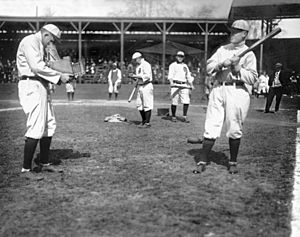
Over time, their relationship changed. Cobb became the biggest star, and Crawford felt jealous. Cobb received special treatment, like private rooms on the road. Crawford said that if he had a good game and Cobb didn't, Cobb would get angry.
In retirement, Cobb and Crawford sometimes spoke negatively about each other. Cobb felt Crawford was jealous of his success. Despite their personal issues, they were very good at playing together on the field. They became one of the most successful double steal pairings in baseball history.
Career Statistics Summary
Ty Cobb has the highest career batting average in Major League Baseball history, at .366. While some older records might show .367, modern research confirms it as .366.
Here are some of Cobb's career totals:
| Games played | At bats | Runs | Hits | Doubles | Triples | Home runs | Runs batted in | Stolen bases | Batting average |
| 3,034 | 11,440 | 2,245 | 4,189 | 724 | 295 | 117 | 1,944 | 897 | .366 |
Cobb also holds a record for outfielders. He committed 271 errors during his career. This is the most by any American League outfielder.
Images for kids
See also
 In Spanish: Ty Cobb para niños
In Spanish: Ty Cobb para niños
- Somewhere in Georgia (1917 film)
- 3,000-hit club
- List of Major League Baseball stolen base records
- List of Major League Baseball hit records
- List of Major League Baseball single-game hits leaders
- List of Major League Baseball player-managers
- List of Major League Baseball individual streaks
- List of Major League Baseball record holders
- Triple Crown
- Major League Baseball titles leaders
- John Franklin Cobb House, home of Cobb's grandfather in Cherokee County, North Carolina
- Ty Cobb Museum
- 1912 Detroit Tigers strike


